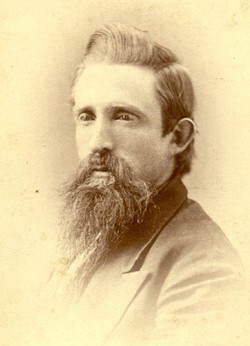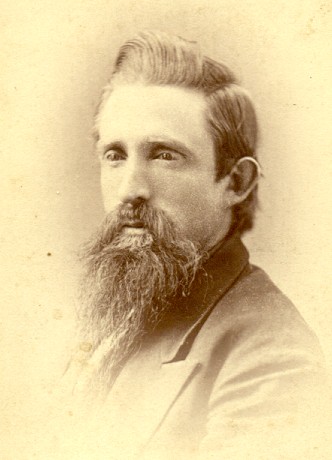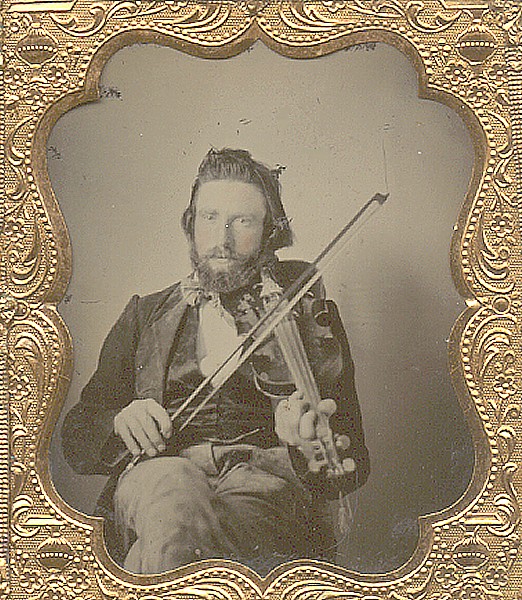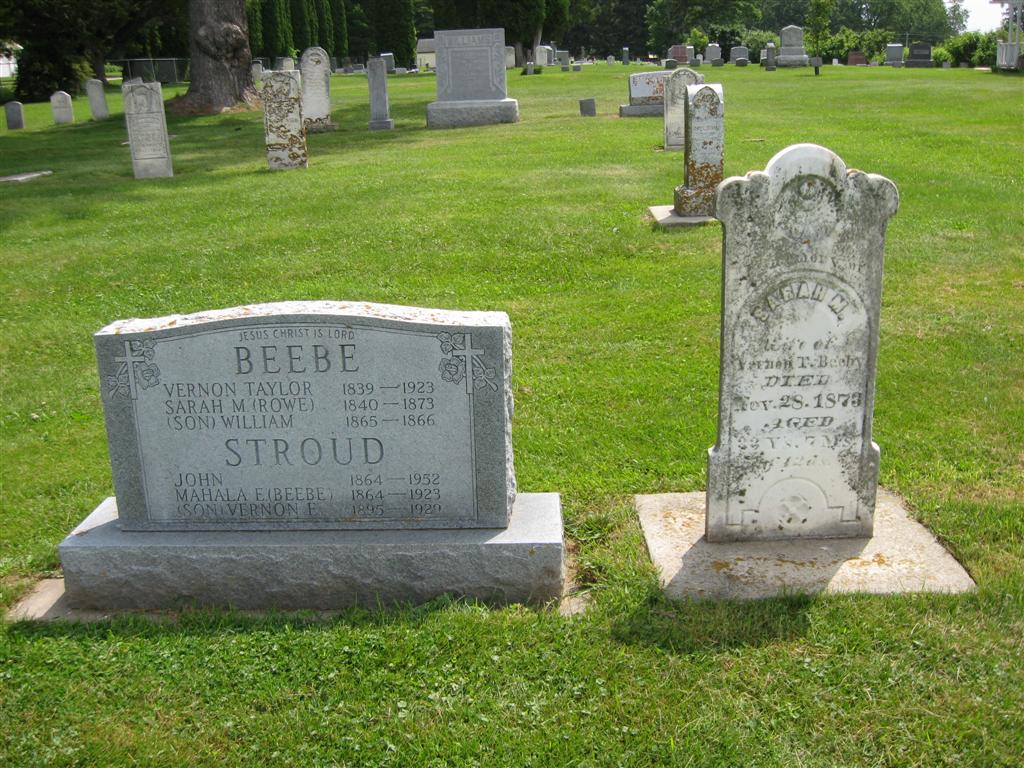When very young, he worked for a drover for seven years, first driving and then buying stock. He was a clerk in a store at Templeville, Md. for one season. In 1857, he came to Riceford, Minn. and was employed at the Brown and Thompson Mill. He was the first schoolteacher in Riceford, teaching in private homes in the area in the summer of 1858. Said to be a very devout Christian, he taught Sunday school and was active in the temperance movement.
On Sep. 6, 1861, he married Sarah Marie Rowe in Spring Grove township, Houston County, Minn. She was the daughter of William Henry Rowe and Mary Gardner Howell. In 1860, Sarah began to keep a journal. After their marriage, Vernon began writing in the same journal. His entry on Christmas Day, 1861, reflects his happiness and love for his wife:
Riceford, December 25, 1861
I am married now, keeping house. How strange it does seem. Only a mere boy and married. One year ago today I first realized that I loved Sarah. She was at Chatfield going to school. Her and Louisa Pendell, J. M. Bigelow and myself hired a horse and sleigh for a sleigh ride. We had a pleasant time. One year has passed and Sarah and I are married. We had a Thanksgiving dinner and some friends came to see us. But we do not need a magnificent Christmas dinner to make us feel happy. Our love for each other is enough. She is sweet and pure as an angel. I hope to always be worthy of her...
In 1864, he and his father-in-law built a new two-story house made with limestone from the quarry on the southwest corner of his 40 acres of land just north of Riceford. The house still stands today. He and his wife and their four youngest children lived in this house for five years.
From 1861 to about 1867, he leased the Brown and Thompson Mill. He then ran the Crystal Mill, which had been purchased by his father-in-law in 1869 and conveyed to his wife Sarah. In 1870, he and Sarah and their children moved out of the stone house and into new living quarters behind the Crystal Mill. With the exception of a few years spent in Hokah and in Lansing, Iowa, he ran the Crystal Mill since 1869. He made many improvements to the mill over the years, adding all the modern appliances of the day to manufacture the finer grades of flour. Two turbine wheels created the power that brought the capacity of the mill to 160 bushels a day. In addition to the mill, there was an engine lathe where iron work could be done.
He and his beloved wife Sarah had six children: Carroll, William, Mahala, Lena, Mildred, and Sadie. Sadie was born on Nov. 26, 1873. Tragically, Sarah died two days later. Her death was a devastating, heart-wrenching loss to Vernon, who recorded his deep grief in the journal that he and Sarah had kept together over the years.
After his wife's death, his son Carroll and daughter Mahala went to live with Sarah's sister Charlotte and her husband, Benjamin Taber. Sadie, Mildred, and Lena went to live with Sarah's sister Mariette and her husband, George Wilcox. These cousins were like brothers and sisters to each other, and remained lifelong friends.
According to journal entries beginning July 12, 1876, Vernon was living in Hokah, Minn. He also spent some time in Lansing, Iowa and operated a sawmill there. A journal entry dated Jan. 19, 1879 indicates he had returned to Riceford, at which time he resumed operation of the Crystal Mill.
According to the History of Houston County published in 1882, he served as Justice of the Peace for at least four years.
After his sister-in-law Mariette died in 1883, his three daughters and Mariette's children lived with their grandparents, William Henry Rowe and his wife Mary. At that time, Vernon resided with them to help supervise the older children. They had fond memories of listening to him play his fiddle and practice with other local musicians who provided the music for local barn dances and other events. His nephew, Eugene Wilcox, who was 10 years old at the time, enjoyed telling stories in his later years about how much fun they had and how good the food tasted when it was made from the grain that had been ground at his uncle's mill.
On June 28, 1886, he was elected President of the Riceford Prohibition Club. In 1887, he published "The Revelator," a newspaper about Adventism. He and his brother-in-law, George Wilcox, had become zealous Adventist preachers. Historian Percival Narveson wrote "Beeby, the head miller and later owner of the Crystal Mill, probably was the most colorful and unforgettable character in the history of Riceford. With his long white beard and hair reaching to his shoulders, he made a deep impression on his audiences as he preached and baptized converts in Riceford Creek."
In 1921, he moved to Garden City, Minnesota to live with his daughter Sadie and her family. He spent his final years under her loving care. He lived to be 84 years of age.
One week has passed away. One more week nearer the grave, glorious thought. Oh haste the time when death shall come. God grant that I may be prepared to meet it at any moment.
-Vernon Taylor Beeby, December 7, 1873
(Bio by: Cindy K. Coffin, (c) 2005)
When very young, he worked for a drover for seven years, first driving and then buying stock. He was a clerk in a store at Templeville, Md. for one season. In 1857, he came to Riceford, Minn. and was employed at the Brown and Thompson Mill. He was the first schoolteacher in Riceford, teaching in private homes in the area in the summer of 1858. Said to be a very devout Christian, he taught Sunday school and was active in the temperance movement.
On Sep. 6, 1861, he married Sarah Marie Rowe in Spring Grove township, Houston County, Minn. She was the daughter of William Henry Rowe and Mary Gardner Howell. In 1860, Sarah began to keep a journal. After their marriage, Vernon began writing in the same journal. His entry on Christmas Day, 1861, reflects his happiness and love for his wife:
Riceford, December 25, 1861
I am married now, keeping house. How strange it does seem. Only a mere boy and married. One year ago today I first realized that I loved Sarah. She was at Chatfield going to school. Her and Louisa Pendell, J. M. Bigelow and myself hired a horse and sleigh for a sleigh ride. We had a pleasant time. One year has passed and Sarah and I are married. We had a Thanksgiving dinner and some friends came to see us. But we do not need a magnificent Christmas dinner to make us feel happy. Our love for each other is enough. She is sweet and pure as an angel. I hope to always be worthy of her...
In 1864, he and his father-in-law built a new two-story house made with limestone from the quarry on the southwest corner of his 40 acres of land just north of Riceford. The house still stands today. He and his wife and their four youngest children lived in this house for five years.
From 1861 to about 1867, he leased the Brown and Thompson Mill. He then ran the Crystal Mill, which had been purchased by his father-in-law in 1869 and conveyed to his wife Sarah. In 1870, he and Sarah and their children moved out of the stone house and into new living quarters behind the Crystal Mill. With the exception of a few years spent in Hokah and in Lansing, Iowa, he ran the Crystal Mill since 1869. He made many improvements to the mill over the years, adding all the modern appliances of the day to manufacture the finer grades of flour. Two turbine wheels created the power that brought the capacity of the mill to 160 bushels a day. In addition to the mill, there was an engine lathe where iron work could be done.
He and his beloved wife Sarah had six children: Carroll, William, Mahala, Lena, Mildred, and Sadie. Sadie was born on Nov. 26, 1873. Tragically, Sarah died two days later. Her death was a devastating, heart-wrenching loss to Vernon, who recorded his deep grief in the journal that he and Sarah had kept together over the years.
After his wife's death, his son Carroll and daughter Mahala went to live with Sarah's sister Charlotte and her husband, Benjamin Taber. Sadie, Mildred, and Lena went to live with Sarah's sister Mariette and her husband, George Wilcox. These cousins were like brothers and sisters to each other, and remained lifelong friends.
According to journal entries beginning July 12, 1876, Vernon was living in Hokah, Minn. He also spent some time in Lansing, Iowa and operated a sawmill there. A journal entry dated Jan. 19, 1879 indicates he had returned to Riceford, at which time he resumed operation of the Crystal Mill.
According to the History of Houston County published in 1882, he served as Justice of the Peace for at least four years.
After his sister-in-law Mariette died in 1883, his three daughters and Mariette's children lived with their grandparents, William Henry Rowe and his wife Mary. At that time, Vernon resided with them to help supervise the older children. They had fond memories of listening to him play his fiddle and practice with other local musicians who provided the music for local barn dances and other events. His nephew, Eugene Wilcox, who was 10 years old at the time, enjoyed telling stories in his later years about how much fun they had and how good the food tasted when it was made from the grain that had been ground at his uncle's mill.
On June 28, 1886, he was elected President of the Riceford Prohibition Club. In 1887, he published "The Revelator," a newspaper about Adventism. He and his brother-in-law, George Wilcox, had become zealous Adventist preachers. Historian Percival Narveson wrote "Beeby, the head miller and later owner of the Crystal Mill, probably was the most colorful and unforgettable character in the history of Riceford. With his long white beard and hair reaching to his shoulders, he made a deep impression on his audiences as he preached and baptized converts in Riceford Creek."
In 1921, he moved to Garden City, Minnesota to live with his daughter Sadie and her family. He spent his final years under her loving care. He lived to be 84 years of age.
One week has passed away. One more week nearer the grave, glorious thought. Oh haste the time when death shall come. God grant that I may be prepared to meet it at any moment.
-Vernon Taylor Beeby, December 7, 1873
(Bio by: Cindy K. Coffin, (c) 2005)
Family Members
-
Ann Beeby Zimmer
1819–1911
-
William Beeby
1822–1870
-
![]()
Mary Beeby
1823–1855
-
![]()
George Beeby Sr
1824–1902
-
![]()
Benjamin Beeby
1827–1910
-
![]()
Elizabeth Taylor "Lizzie" Beeby Maison
1827–1921
-
Hannah Beeby Tompkins
1828–1859
-
![]()
Sgt. Richard Beeby
1832–1900
-
![]()
Susan T Beeby Martin
1835–1863
-
![]()
Pvt Daniel W. Beeby Beebe Jr
1836–1923
-
![]()
Israel Pyle Beebe
1839–1919






















